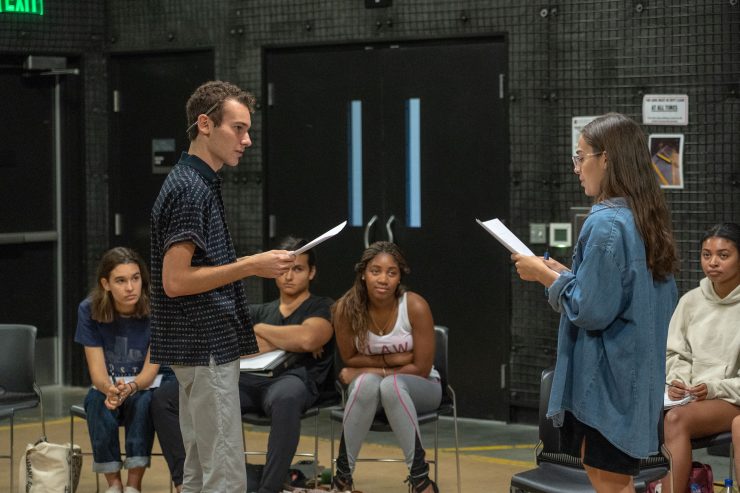Program Spotlight: Screenwriting So you want to become a screenwriter?
January 7, 2019
The old joke says that every waiter in Hollywood is actually a screenwriter who is likely to hand you a script along with your burger and fries. While producers and directors in Hollywood may or may not be so accosted, there are plenty of aspiring screenwriters looking for ways to break into the business. But as even the most successful can attest, it’s a demanding and highly competitive endeavor.
That, of course, does not deter young writers who have a passion to tell stories and look for guidance to sharpen their skills – and their chances – for what can be a tremendously satisfying career. A degree in screenwriting offers a clear path for learning from those who have gone before about how to avoid some of the pitfalls in the business and how to sharpen your storytelling skills for the screen.
Beyond talent, perseverance and the willingness to sit alone in a room for endless hours, what are the key lessons aspiring screenwriters need to learn? We asked Dodge College screenwriting faculty to share some of their insights drawn from their years in the business – and in the classroom – about what young screenwriters need to know and how a screenwriting degree from Dodge College can help them on their way.
Deciding What Stories to Tell
 Facing the blank page, students may be challenged to decide what story to tell. Faculty often encourage students to mine their own experience, taking into account that, as students, their experience may be limited.
Facing the blank page, students may be challenged to decide what story to tell. Faculty often encourage students to mine their own experience, taking into account that, as students, their experience may be limited.
“I encourage students to write from their authentic selves and interests,” says Professor Bettina Gilois. “They don’t have to have flown a plane to write about a pilot, but they should be able to identify with what makes a pilot tick.”
Other faculty insist that students work harder to observe in their own lives. Professor Anne Beatts declares “no sci-fi, no robots, no flying dragons, no magical elves, no monsters,” a policy she says some students may hate, “but, in the end, I think their work is the better for it. I try to encourage them to find the interest and excitement in the mundane and every day. I tell them that a lot of great writing is just two people talking. And I show them examples.”
The process of screenwriting also demands finding one’s own voice, knowing that a familiar story can be told from a unique perspective. “Life is repetitive,” says Professor Ron Friedman, so it is the distinctive voice which makes the familiar news. “How many still life paintings have you seen?” he asks. “It’s always the checkered tablecloth, bottle of wine, guitar or vase of flowers and yet each one can be different and arresting and force you to reexamine the familiar – to see it again but this time for the first time – because the artist has processed it through his or her own eyes.”
Researching New Worlds, Finding the Specific
Research is the key to writing outside of one’s own experience because, “If we just write about what we know, we are doomed to cultural naval gazing,” says Professor Michael Schiffer. And, he adds, “Research is not only essential to sophisticated storytelling, it can be tremendously rewarding for the writer who gets to enter more interesting worlds.”
Letting Your Characters Tell Their Story
 The process of learning to write a screenplay also means divorcing oneself from other forms of writing. As Professor Schiffer explains, “Most people are taught to think and write analytically, making points that support their arguments, but that’s not how it works in the dramatic arts.
The process of learning to write a screenplay also means divorcing oneself from other forms of writing. As Professor Schiffer explains, “Most people are taught to think and write analytically, making points that support their arguments, but that’s not how it works in the dramatic arts.
“Dramatic storytelling is not about what the writer thinks or wants, it’s about what the characters want and need and what the tale itself demands, in a world where the writer disappears,” he continues. “To bring scenes and stories to life, we can’t dictate what our characters are supposed to do or say, we have to take a leap of faith and become each character, working improvisationally inside each moment.”
Writing for the Screen, Not the Page
A big part of a screenwriting education is learning how to “show,” rather than “tell” a story. Faculty work with students to avoid getting preachy, using a character as a mouthpiece for the writer’s opinions. At the same time, learning the art of subtext is a key element in creating characters and situations that move the story forward without beating the audience over the head with the obvious.
Professor Paul Gulino explains his understanding of subtext as “closer to how actors view it. Subtext is the underlying action of a line of dialogue. I.e., what is the character trying to do with the line of dialogue? Is the character attacking? Defending? Seducing? Accusing? Deflecting? As an exercise I encourage my students to look at each line of dialogue and find out if there is a verb underlying it. If not, try to remove it.”
Giving and Taking Notes

A huge part of a screenwriting education is giving and taking notes, because, as professor after professor will tell you, writing is rewriting. Students need to learn to “kill their darlings,” or sacrifice their favorite lines or scenes if they don’t forward the story, and to create characters who aren’t just black and white. (“Even Hitler loved his dog,” notes Professor Beatts.) But giving and taking criticism can be a delicate dance.
At Chapman, a big part of how faculty approach critiques is “treating students as fellow collaborators,” says Professor Gulino, and getting student screenwriters to see that the success of a script depends on how successfully it communicates what the writer intends to the audience. Classmates, table reads and group critiques stand in for the audience. “If 14 different writers think your pages aren’t working either technically or emotionally, you might want to rethink those pages,” says Professor Dutcher. “If you’re not communicating effectively, you are not doing your job.”
Pushing the Envelope
To further develop both the research skills needed by screenwriters and their knowledge of market trends and possibilities, the undergraduate screenwriting program is offering two new courses this year. Just last year, the screenwriting degree moved from a BA to a BFA with an increase in credits from 48 to 66 to provide more substance and depth, says Film Division Chair Pavel Jech, and “to acknowledge and prepare students for the dynamic changes currently affecting this field,” including preparing students to work in new formats and genres.
What Distinguishes Screenwriting at Chapman
As the philosophy of Dodge College is driven by hiring faculty who didn’t learn to make movies out of books, but rather learned by doing, so the screenwriting faculty brings top credits to the classroom– major, commercially successful films, feature films that you would have seen and heard of, as well as many independent projects and TV movies and series too numerous to mention.
- Start with David Ward’s Oscar for The Sting, but also note his credits on Sleepless in Seattle and Major League (in all its versions), as well as King Ralph, Cannery Row and more.
- Check out Barry Blaustein’s run with Eddie Murphy on The Nutty Professor and Coming to America, his work on the Police Academy series and his wresting documentary Beyond the Mat.
- Take a class with Michael Schiffer, who wrote not only Crimson Tide, Lean on Me, Colors, and The Peacemaker, but also scripts for the Call of Duty video game.
- Find out what’s funny from Anne Beatts, one of the original writers on Saturday Night Live, with credits on more than 100 episodes.
- Or try to spend more than five minutes without laughing with Ron Friedman, whose 80 credits on IMDB range from the animated Transformers: The Movie to classic television shows spanning 40 years.
- And it goes without saying, there are many, many more, too many to list here.
This article has been condensed for our blog. Check out the full article that was originally published in our Fall 2018 In Production Magazine.This issue focuses on exploring identity through filmmaking, alumni honing their skills on the latest CFE production, Chapman’s third Student Academy Award-win, and a spotlight on our Screenwriting program. Check out the full magazine on issuu.


